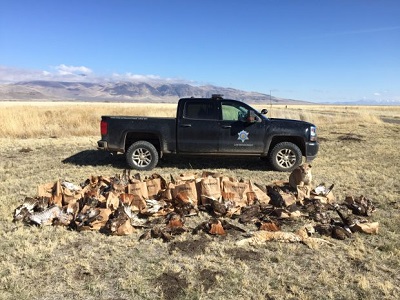 California wildlife officers have uncovered what is likely the largest poaching case of raptors in known California history, the California Department of Fish and Wildlife (CDFW) announced.
California wildlife officers have uncovered what is likely the largest poaching case of raptors in known California history, the California Department of Fish and Wildlife (CDFW) announced.
Wildlife officers assigned to Lassen County received an anonymous tip from someone who reportedly witnessed a man killing a hawk near the town of Standish. The local wildlife officer conducted surveillance, then visited the private property and discovered nine dead raptors, which was enough evidence to obtain a search warrant. He returned on March 11 with additional officers and a CDFW K-9. A search of the 80-acre property led to the discovery of an extraordinary number of raptor carcasses, other dead birds and wildlife and spent rifle casings indicating more than 140 potential state and/or federal violations.
In addition to the original nine birds, they found 126 dead raptors, all in various states of decay. Most of the birds were red-tailed hawks, but at least one dead owl was found, as well as an uncommon migratory ferruginous hawk. Officers also located two dead bobcats, one taxidermied mountain lion and other nongame birds, all suspected to be unlawfully taken.
Property owner Richard Parker, 67, was booked into Lassen County jail on multiple charges including take of birds of prey, take of migratory nongame birds as designated by the federal Migratory Bird Treaty Act, take of other nongame birds, and possession of wildlife unlawfully taken. Additional charges may be added as the investigation proceeds.
Staff at CDFW’s Wildlife Investigations Laboratory in Rancho Cordova are working to positively identify the species of all of the birds.
As the top bird predators in the food chain, raptors serve an important role in the ecosystem by controlling rodent and small mammal populations. However, they are also particularly susceptible to environmental stressors such as drought and habitat loss. For these reasons, biologists refer to them as an indicator species.
Standish is located near Honey Lake and the Honey Lake Wildlife Area, with habitat that supports a rich diversity and quantity of wildlife. The sheer number of birds poached on the 80-acre property will undoubtedly affect the raptor population in the immediate area.
“Poaching crimes of this egregious nature against raptors is unprecedented in California,” said David Bess, CDFW Deputy Director and Chief of the Law Enforcement Division. “The local raptor population may take years to recover from these killings.”
Each potential violation is a misdemeanor poaching crime at the state level, with maximum penalties of six months in jail and up to a $5,000 fine per each raptor. An unlawfully taken mountain lion could result in up to a $10,000 penalty. Each potential federal crime could result in additional penalties.
Media Contact:
Capt. Patrick Foy, CDFW Law Enforcement, (916) 651-6692
